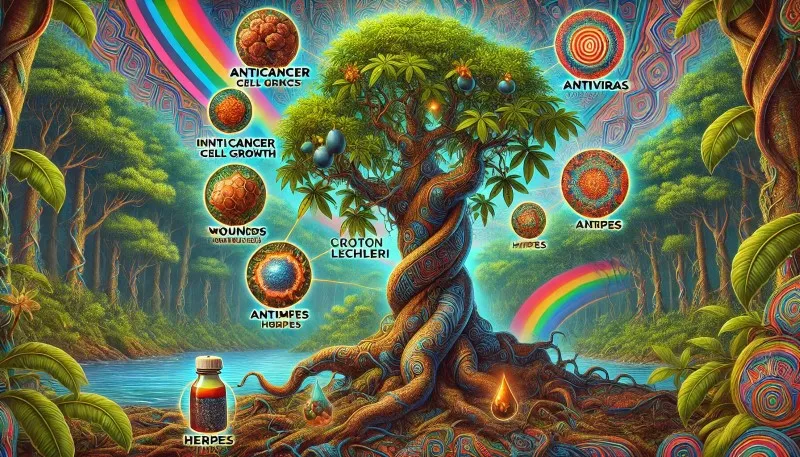Sangre de Grado, or Dragon’s Blood (Latin: Croton lechleri, croton lechleri) is one of the most mysterious and powerful remedies in the arsenal of Amazonian traditional medicine. It gets its name from the bright red resin of the tree, which resembles the blood of a mythical dragon. This plant has been used for centuries to treat various diseases and improve the general condition of the body. In this article we will consider the history and origin of this plant, its chemical composition, therapeutic properties, as well as modern use in pharmaceuticals and cosmetology.
History and origin of the Croton Lechler plant
Historical overview
Europeans have known the use of Croton lechleri resin for medicinal purposes for several centuries. In the 17th century, the Jesuit Bernabe Cobo detailed how “sangre de grado” was used among the indigenous peoples of Mexico, Peru and Ecuador. This plant was known for its properties to heal wounds, stop bleeding and prevent infections. Spanish conquistadors, seeing the effectiveness of this remedy, brought it to Europe, where it became popular among healers and explorers.
Geographical distribution
Croton lechleri grows in the Amazon rainforest, covering the territories of Peru, Colombia, Ecuador and Brazil. These regions are renowned for their rich ecosystems, home to many unique plants with powerful medicinal properties. The humid climate and fertile soils create ideal conditions for the growth of Croton lechleri. The Amazonian tropical forests are one of the most biologically diverse regions on the planet. It is home to a huge number of medicinal plants, many of which are still unexplored. Croton lechleri is one such plant whose properties and potential applications continue to be studied by scientists and researchers around the world.
Chemical composition and active components of the Dragon’s Blood plant
Main constituents
The main active components of Dragon’s Blood include saponins, alkaloids and flavonoids. These substances have a complex effect on the body, contributing to its recovery and defence against various diseases. A special place among them is occupied by the alkaloid taspin, which has powerful healing and anti-inflammatory properties. In addition to taspin, Dragon’s Blood contains a number of other active substances, including proanthocyanidins and catechin, which also contribute to its therapeutic properties.
Mechanisms of Action
The active components of Croton lechleri affect the body at the cellular level, promoting tissue regeneration and strengthening the immune system. Scientific studies have confirmed the effectiveness of these substances in the treatment of various diseases, including infectious and inflammatory processes. Taspin has anti-tumour and antiviral properties, making it an important component in the fight against various diseases. When applied to the skin, resin of Croton lechleri dries quickly, forming a protective layer that protects the wound from infection and promotes its rapid healing. This effect makes Dragon’s Blood a good treatment for wounds and burns. Internal use of the extract helps to strengthen the immune system and fight infections due to its powerful anti-inflammatory and antimicrobial properties.
Healing properties and uses
- Wound healing and antiseptic properties
The resin of Dragon’s Blood has traditionally been used to treat wounds and burns. The book The Healing Power of Rainforest Herbs by naturopath Leslie Taylor details that a quality extract of Dragon’s Blood helps stop bleeding, accelerates wound healing and protects against infection. When applied to injured areas, the juice dries quickly, creating a protective barrier similar to a “second skin” that promotes rapid healing and prevents infections. Studies show that dragon’s blood has a significant effect on wounds. In one study, a group of 60 people used dragon’s blood cream or a placebo on a fresh wound for 20 days.At the end of the trial, those who used the cream with the active ingredient experienced a much greater degree of healing than those who used the placebo.There was an improvement in healing as early as day 3 of using the cream.Researchers believe this is due to the phenolic compounds found in dragon’s blood, as well as the healing alkaloid taspin. These polyphenolic compounds create a protective layer on the surface of the skin that prevents harmful microbes from entering, and all of these molecules condense and bind to surrounding proteins, plugging the wound and causing vasoconstriction at the wound site, which is key to healing.
- Antitumour and antiviral properties
Leslie Taylor’s book also attributes anti-tumour and antiviral properties to taspin. Studies in several countries have confirmed these observations, demonstrating that the taspin alkaloid plays a key role in fighting tumours and viral infections. This makes Croton lechleri an important tool in modern medicine. The anti-tumour properties of taspin are related to its ability to inhibit the growth of cancer cells and prevent their spread. Its antiviral properties allow it to effectively fight various viral infections, including herpes and HIV. A study published in 2004 confirms the effectiveness of traditional applications of Dragon’s Blood. Results show that its use helps in the treatment of diarrhoea, wounds, tumours, stomach ulcers, herpetic infections, itching, pain and swelling from insect bites.
- Anti-inflammatory and analgesic effects
In folk medicine, Dragon’s Blood is used to relieve inflammation and pain, including muscle and joint pain. This makes it indispensable for treating injuries and chronic inflammatory conditions.
- Immune System Support
Regular use of Croton lechleri resin helps to strengthen the immune system, protecting the body from viruses and bacteria. This is especially important during seasonal illnesses and epidemics. Croton lechleri resin contains phenolic compounds such as proanthocyanidins and catechin, which help reduce inflammation and strengthen the immune system. These compounds have powerful antioxidant properties, protecting cells from damage and promoting cell regeneration.
Lechler’s croton in cosmetics
Dragon’s blood is highly valued in the skin care industry due to this plant resin’s ability to soothe, moisturise and smooth the skin, slow down the ageing process, and repair damaged skin.
Key skin properties:
- Antioxidant
The resin is rich in flavonoids and phenols. These natural plant compounds have antioxidant properties and help the body eliminate cell-damaging free radicals that can threaten our health. Antioxidants are great for skin health because they help protect the skin from damage caused by UV rays and inflammation, two of the dermis’ main enemies that cause wrinkles.
- Improves collagen production
Dragon’s blood has a pro-collagen effect on the skin. It contains enzymes that actively bind collagen fibres in the skin, thus repairing dead and worn-out tissues and making the skin firm and smooth.
- Skin Moisturising
Dragon’s blood helps prevent moisture loss in the skin by creating a protective layer that helps retain moisture.
- Reduces inflammation
The anti-inflammatory properties of the plant’s active ingredient eliminate puffiness and bags under the eyes from the facial skin. Studies show that dragon’s blood applied externally to the epidermis is an effective solution for reducing redness and sensitivity, signs of various skin problems such as eczema, sunburn, acne and psoriasis.
- It has antimicrobial properties
Due to the phenolic compounds within the resin, the growth of pathogens is inhibited . This is ideal for skin problems such as acne, which are exacerbated by an imbalance of bacteria on the skin.
- Protects the skin
The Croton lechleri tree, when damaged, releases a resin that fills the area with highly concentrated nutrients, protecting the tree from infection and preventing insect attacks.This is very similar to the human healing system, which causes blood to clot around a wound and form a scab, preventing infection.Dragon’s blood acts in much the same way as our own skin. When the juice dries, it forms a protective membrane-like layer that shields the dermis from pathogens and environmental damage.
Dragon’s blood in pharmaceuticals
Today, Croton lechleri is used to produce various medicines including ointments, balms and capsules. These preparations are used to treat wounds, inflammation and infections. In 2012, the U.S. Food and Drug Administration (FDA) approved the marketing of Mytesi, a crofelemer-based product for the relief of antiretroviral-induced diarrhoea in patients with HIV. Mytesi is an innovative drug that helps HIV patients manage the side effects of antiretroviral therapy. Crofelemer, the active ingredient in Mytesi, is extracted from Croton lechleri resin and has potent anti-diarrhoeal properties, making it an important tool in the treatment of patients with HIV.
Alternative medicine and self-development practices
Many self-development practices include the use of sangre de grado in rituals and meditations. It helps to focus, clear the mind and enhance energy flows in the body. In ayahuasca retreats, Dragon’s Blood is used to purify and protect the aura, enhance energy flows and improve meditative practices. Dragon’s Blood is a unique herb that has powerful healing properties. Its use covers a wide range of medical and cosmetic procedures, making it an indispensable tool in the arsenal of modern healers and cosmetologists. Scientific research and numerous success stories confirm its efficacy and safety, and Dragon’s Blood continues to be a subject of interest to scientists and researchers, who are discovering more and more aspects of its use. This Plant Medicine has great potential for use in medicine and cosmetology, and its study continues around the world. Links to scientific articles on Dragon’s Blood (in English) are provided for further study of the topic:
Alejandro, A. S. A. (2024, May 29). Estudios preliminares del potencial terapéutico del (Croton lechleri) sangre de grado. https://repositorio.ucsm.edu.pe/items/8d202a0d-389f-4fe9-99cc-f336f370fcf6
Carlson, T. J. (2002). Medical ethnobotanical research as a method to identify bioactive plants to treat infectious diseases. In Advances in phytomedicine (pp. 45-53). https://doi.org/10.1016/s1572-557x(02)80012-5
Cevallos-Morillo, C., Cisneros-Pérez, P., Llive, R., Ricaurte, M., Reinoso, C., Meneses, M. A., Del Cisne Guamán, M., & Palma-Cando, A. (2021). Croton lechleri Extracts as Green Corrosion Inhibitors of Admiralty Brass in Hydrochloric Acid. Molecules/Molecules Online/Molecules Annual, 26(24), 7417. https://doi.org/10.3390/molecules26247417Jones, K. (2003).
Review ofSangre de Drago(Croton lechleri) – A South American Tree Sap in the Treatment of Diarrhea, Inflammation, Insect Bites, Viral Infections, and Wounds: Traditional Uses to Clinical Research. The Journal of Alternative and Complementary Medicine/Journal of Alternative and Complementary Medicine, 9(6), 877-896. https://doi.org/10.1089/107555303771952235Martel, K. P. C., Buitrón, M. R. O., & Bernardo, Y. B. (2019).
Efectividad de la sangre de grado (croton lechleri) en la cicatrización de heridas post exodoncia en adultos. https://www.redalyc.org/journal/5860/586062182001/ Peres, I. S. A., Conceição, K. a. O., Silva, L. a. F., Khouri, N. G., Yoshida, C. M. P., Concha, V. O. C., Lucarini, M., Durazzo, A., Santini, A., Souto, E. B., & Severino, P. (2023).
Dragon’s Blood: antioxidant properties for nutraceuticals and pharmaceuticals. Rendiconti Lincei. Scienze Fisiche E Naturali, 34(1), 131-142. https://doi.org/10.1007/s12210-022-01122-4
Want to learn more about medicinal plants? Read interesting articles on our website on the topic:
Bobinsana: Plant Medicine that helps to combine Power and Love






